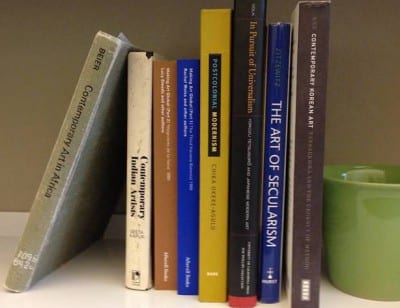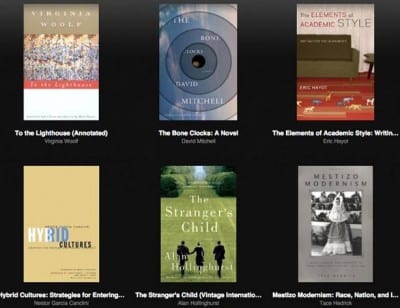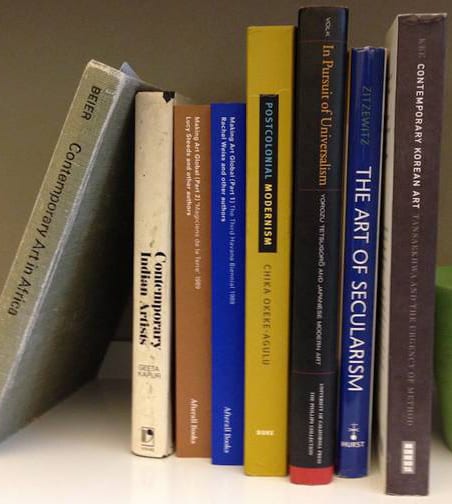Editor’s Note: Bookshelf is a new series on Art Journal Open that takes a peek at the personal reading lists of art historians, artists, curators, and other arts professionals. First up: Art Journal’s incoming Editor-in-Chief, Rebecca M. Brown.

I’m presenting my bookshelf at the end of the semester, a time when I’m fully immersed in the questions and discussions of my classroom and seminar table, so my shelf is a reflection of that ongoing and still percolating conversation. I’ve been teaching courses on the global modern this spring, and that has meant I’ve had a wonderful time reading across the globe in new ways, introducing myself and my students to texts in African, Latin American, and Asian modernisms outside of my own area of South Asian art. It’s been incredibly rich—we read some “classics” side-by-side in one seminar—early publications of Ulli Beier and Geeta Kapur served as an interesting conversation starter in relation to some of the more recent engagements with modernism, including Alicia Volk’s book on Yorozu Tetsugorō, Karin Zitzewitz’s exploration of questions of the secular in India, Joan Kee’s examination of a particular abstract movement within Korea, and Chika Okeke-Agulu’s close reading of the 1950s and 1960s in Nigeria. The two books in the Making Art Global series on Magiciens de la Terre and the Third Havana Biennial were wonderful sources for discussion, and will be crucial reference works for teaching and thinking about these important exhibitions.
I work in both analog and digital, so my academic pursuits extend to the Kindle—we discussed questions of hybridity in several seminars this term, and both Néstor García-Canclini and Tace Hedrick’s interventions were crucial for guiding our conversation in relation to the discussion of Latin American modernism. I’m incredibly excited and energized by these books—I feel that we are finally creating a foundation for a larger conversation about the modern that might truly be grounded in particular examples and histories. I can’t wait to keep reading and see what’s next.

In my spare time, I enjoy reading writing about writing—I’m a huge David Foster Wallace fan. I’m halfway through Eric Hayot’s book on writing in the humanities. I started reading it because I thought I might recommend it to my graduate students, and I’m finding some interesting ways of thinking about writing for my own practice as well, which is a wonderful gift. I managed to finish Alan Hollinghurst’s The Stranger’s Child and David Mitchell’s The Bone Clocks over the past six months—I truly enjoyed Hollinghurst’s exploration of memory, archive, and history, and Mitchell’s folding over of time and weaving together of narratives has long captivated me. After those two lengthy books I decided to turn to an old friend: Virginia Woolf. It’s been ages since I read To the Lighthouse (I think I was in high school?), and it’s such a treat to re-read. Memory, return, and folding of time indeed.
My Reading List:
Ulli Beier, Contemporary Art in Africa (New York: F. A. Praeger, 1968)
Néstor García Canclini, Hybrid Cultures: Strategies for Entering and Leaving Modernity (Minneapolis: University of Minnesota Press, 1989)
Eric Hayot, The Elements of Academic Style: Writing for the Humanities (New York: Columbia University Press, 2014)
Tace Hedrick, Mestizo Modernism: Race, Nation, and Identity in Latin American Culture, 1900–1940 (New Brunswick, NJ: Rutgers University Press, 2003)
Alan Hollinghurst, The Stranger’s Child (New York: Alfred A. Knopf, 2011)
Geeta Kapur, Contemporary Indian Artists (New Delhi: Vikas, 1978)
Joan Kee, Contemporary Korean Art: Tansaekhwa and the Urgency of Method (Minneapolis: University of Minnesota Press, 2013)
David Mitchell, The Bone Clocks (New York: Random House Inc., 2015)
Chika Okeke-Agulu, Postcolonial Modernism: Art and Decolonization in Twentieth-Century Nigeria (Durham, NC: Duke University Press, 2014)
Lucy Steeds, et al., Making Art Global: Part 2, Magiciens de la terre, 1989 (London: Afterall Books, 2013)
Alicia Volk, In Pursuit of Universalism: Yorozu Tetsugorō and Japanese Modern Art (Berkeley: University of California Press, 2010)
Rachel Weiss, Luis Camnitzer, Alex Ángeles, Lucy Steeds, and Charles Esche, Making Art Global: Part 1, The Third Havana Biennial, 1989 (London: Afterall Books, 2011)
Virginia Woolf, To the Lighthouse (New York: Harcourt, Brace & Co., 1927)
Karin Zitzewitz, The Art of Secularism: The Cultural Politics of Modernist Art in Contemporary India (London: Hurst & Co., 2014)
Rebecca M. Brown (Johns Hopkins University) is a scholar of colonial and post-1947 South Asian art, visual culture, museum studies, and politics. She has curated several modern and contemporary Indian art exhibitions. Brown has published widely on architecture in colonial India, modernity and visual culture in twentieth-century India, and the imagery of the spinning wheel from the colonial era to Gandhi’s deployment of it for the nationalist movement. Her next book examines the role of temporality in the art exhibitions of the 1985–86 Festival of India in the US, and she is researching a book on the global modern. She is the editor-in-chief of Art Journal.

